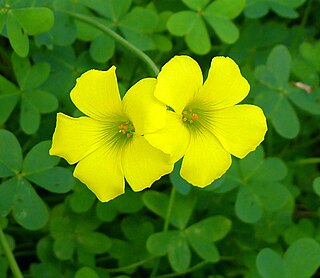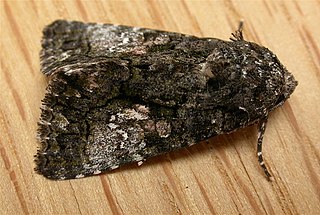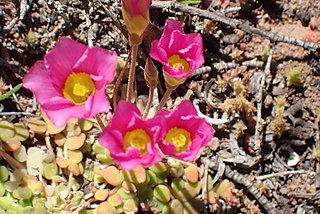
The Noctuidae, commonly known as owlet moths, cutworms or armyworms, are a family of moths. Taxonomically, they are considered the most controversial family in the superfamily Noctuoidea because many of the clades are constantly changing, along with the other families of the Noctuoidea. It was considered the largest family in Lepidoptera for a long time, but after regrouping Lymantriinae, Catocalinae and Calpinae within the family Erebidae, the latter holds this title now. Currently, Noctuidae is the second largest family in Noctuoidea, with about 1,089 genera and 11,772 species. This classification is still contingent, as more changes continue to appear between Noctuidae and Erebidae.

Oxalis is a large genus of flowering plants in the wood-sorrel family Oxalidaceae, comprising over 550 species. The genus occurs throughout most of the world, except for the polar areas; species diversity is particularly rich in tropical Brazil, Mexico, and South Africa.
Buttercups are several species of the genus Ranunculus.
Sourgrass is a common name given to several plant species which have a sour taste. Most are in fact not grasses:

Cutworms are moth larvae that hide under litter or soil during the day, coming out in the dark to feed on plants. A larva typically attacks the first part of the plant it encounters, namely the stem, often of a seedling, and consequently cuts it down; hence the name cutworm. Cutworms are not worms, biologically speaking, but caterpillars.

Oxalis pes-caprae is a species of tristylous yellow-flowering plant in the wood sorrel family Oxalidaceae. Oxalis cernua is a less common synonym for this species. Some of the most common names for the plant reference its sour taste owing to oxalic acid present in its tissues. Indigenous to South Africa, the plant has become a pest plant in different parts of the world that is difficult to eradicate because of how it propagates through underground bulbs.

Ipomoea pes-caprae, also known as bayhops, bay-hops, beach morning glory, railroad vine, or goat's foot, is a common pantropical creeping vine belonging to the family Convolvulaceae. It grows on the upper parts of beaches and endures salted air. It is one of the most common and most widely distributed salt tolerant plants and provides one of the best known examples of oceanic dispersal. Its seeds float and are unaffected by salt water.
Goat's foot is a common name for several plants and may refer to:
Mycobacterium caprae is a species of bacteria in the genus Mycobacterium and a member of the Mycobacterium tuberculosis complex. The species is named after the caprines, the organisms from which M. caprae was first isolated. Prior to 2003, the species was referred to as Mycobacterium tuberculosis subsp. caprae. It is also synonymous with the name Mycobacterium bovis subsp. caprae.

Oxalis stricta, called the common yellow woodsorrel, common yellow oxalis, upright yellow-sorrel, lemon clover, or more ambiguously and informally "sourgrass", "juicy fruit","sheep weed", or "pickle plant", is a herbaceous plant native to North America, parts of Eurasia, and a rare introduction in Britain. It tends to grow in woodlands, meadows, and in disturbed areas as both a perennial and annual. Erect when young, this plant later becomes decumbent as it lies down, and branches regularly. It is not to be confused with similar plants in the same genus which are also often referred to as "yellow woodsorrel".

Oxalis triangularis, commonly called false shamrock, is a species of perennial plant in the family Oxalidaceae. It is native to several countries in southern South America. This woodsorrel is typically grown as a houseplant but can be grown outside in USDA climate zones 8a–11, preferably in light shade.

The West Coast National Park lies 88 km (55 mi) north of Cape Town in the Western Cape province of South Africa. The park is found inside of the Cape West Coast Biosphere Reserve, part of the UNESCO Man and the Biosphere Programme. It is bordered by the Atlantic Ocean on the west and the R27 coastal road, and runs from the town of Yzerfontein in the south, up to the Langebaan Lagoon. The park is particularly well known for its bird life and for the spring flowers which occur in the months from August to September, especially in the Postberg flower reserve section of the park. The park, with the islands in Saldanha Bay, has been identified by BirdLife International as an Important Bird Area. The park was proclaimed in 1985, and is 36,259.8 hectares (140.000 sq mi) in size.

Aedia leucomelas, the eastern alchymist, sweet potato leaf worm or sorcerer, is a moth of the family Noctuidae. It is found in large parts of the world, ranging from Europe all over Asia up to Japan and some African countries. The subspecies Aedia leucomelas acronyctoides is found in Australia.
Pes-caprae is Latin for "goat's foot" and may refer to:

The Wedgling Moth is a moth of the family Noctuidae. It is found from most of North America south to Guatemala and the Caribbean. It is also present on the Azores, Madeira and the Canary Islands.

Scutiger pes-caprae, commonly known as the goat's foot, is a species of fungus in the family Albatrellaceae. It was first described officially as a species of Polyporus by Christian Hendrik Persoon in 1818. In recent decades, it was known most commonly as a species of Albatrellus until molecular research published by Canadian mycologist Serge Audet in 2010 revealed that it was more appropriate in an emended version of the genus Scutiger.

Ipomoea imperati, the beach morning-glory, is a species of flowering plant in the family Convolvulaceae. Like Ipomoea pes-caprae, its seeds disperse by floating in seawater. It has been found on the sandy shores of every continent except Antarctica.

Oxalis inaequalis is a bulb-forming species of flowering plant in the wood sorrel family. It is native to South Africa's Cape Provinces. Each plant produces a rosette of up to 70 succulent leaves, which occasionally produce aerial bulbs. The flowers are yellow and copper-coloured. The sepals are of unequal sizes, hence the specific epithet "inaequalis", which is Latin for "unequal".













